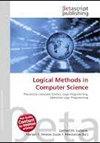Fixpoint Theory -- Upside Down
IF 1
4区 数学
Q4 COMPUTER SCIENCE, THEORY & METHODS
引用次数: 1
Abstract
Knaster-Tarski's theorem, characterising the greatest fixpoint of a monotone function over a complete lattice as the largest post-fixpoint, naturally leads to the so-called coinduction proof principle for showing that some element is below the greatest fixpoint (e.g., for providing bisimilarity witnesses). The dual principle, used for showing that an element is above the least fixpoint, is related to inductive invariants. In this paper we provide proof rules which are similar in spirit but for showing that an element is above the greatest fixpoint or, dually, below the least fixpoint. The theory is developed for non-expansive monotone functions on suitable lattices of the form $\mathbb{M}^Y$, where $Y$ is a finite set and $\mathbb{M}$ an MV-algebra, and it is based on the construction of (finitary) approximations of the original functions. We show that our theory applies to a wide range of examples, including termination probabilities, metric transition systems, behavioural distances for probabilistic automata and bisimilarity. Moreover it allows us to determine original algorithms for solving simple stochastic games.定点理论——颠倒过来
Knaster-Tarski定理,将完全格上单调函数的最大不动点描述为最大后不动点,自然导致所谓的协归纳证明原理,用于显示某些元素低于最大不动点(例如,用于提供双相似性见证)。对偶原理,用于证明一个元素在最小不动点以上,与归纳不变量有关。在本文中,我们提供了在精神上类似的证明规则,只是为了证明一个元素在最大不动点以上,或者对偶地在最小不动点以下。该理论是在$\mathbb{M}^Y$形式的合适格上的非膨胀单调函数上发展起来的,其中$Y$是一个有限集合,$\mathbb{M}$是一个v -代数,它是基于原始函数的(有限)逼近的构造。我们表明,我们的理论适用于广泛的例子,包括终止概率,度量转移系统,概率自动机的行为距离和双相似性。此外,它还允许我们确定解决简单随机博弈的原始算法。
本文章由计算机程序翻译,如有差异,请以英文原文为准。
求助全文
约1分钟内获得全文
求助全文
来源期刊

Logical Methods in Computer Science
工程技术-计算机:理论方法
CiteScore
1.80
自引率
0.00%
发文量
105
审稿时长
6-12 weeks
期刊介绍:
Logical Methods in Computer Science is a fully refereed, open access, free, electronic journal. It welcomes papers on theoretical and practical areas in computer science involving logical methods, taken in a broad sense; some particular areas within its scope are listed below. Papers are refereed in the traditional way, with two or more referees per paper. Copyright is retained by the author.
Topics of Logical Methods in Computer Science:
Algebraic methods
Automata and logic
Automated deduction
Categorical models and logic
Coalgebraic methods
Computability and Logic
Computer-aided verification
Concurrency theory
Constraint programming
Cyber-physical systems
Database theory
Defeasible reasoning
Domain theory
Emerging topics: Computational systems in biology
Emerging topics: Quantum computation and logic
Finite model theory
Formalized mathematics
Functional programming and lambda calculus
Inductive logic and learning
Interactive proof checking
Logic and algorithms
Logic and complexity
Logic and games
Logic and probability
Logic for knowledge representation
Logic programming
Logics of programs
Modal and temporal logics
Program analysis and type checking
Program development and specification
Proof complexity
Real time and hybrid systems
Reasoning about actions and planning
Satisfiability
Security
Semantics of programming languages
Term rewriting and equational logic
Type theory and constructive mathematics.
 求助内容:
求助内容: 应助结果提醒方式:
应助结果提醒方式:


